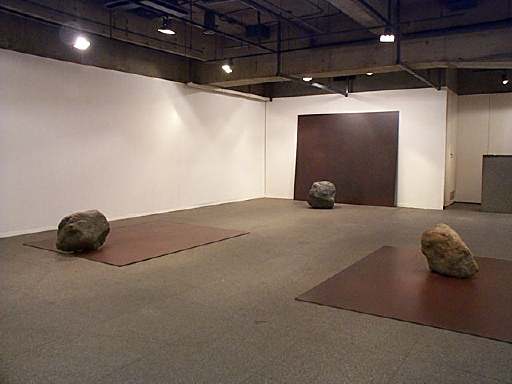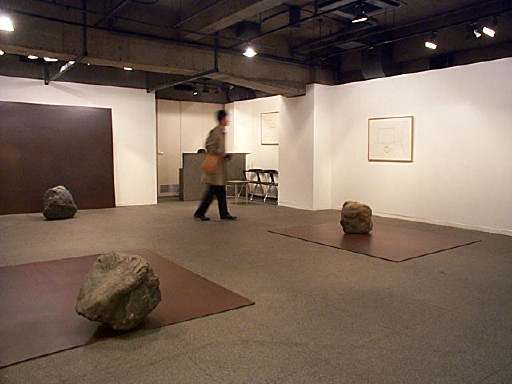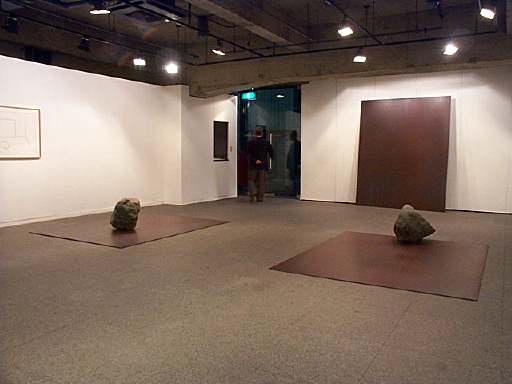January 22 – February 24, 1999

Ulrich Rückriem cuts rectangles of stone from massive quarries, further divides these stones into pieces and places them in an exhibition space. Richard Long gathers accessible fragments of rock from the mountainside and lines them up in the gallery. I select a few stones from among the countless stones found along river sides and at stonemasons and then combine them with steel plates in museums.
While we all use stones, there is an even more fundamental resemblance among us. We all borrow our works of art from nature, we quote from nature. By looking at our works, your gaze immediately extends on to the quarries, the mountains, the river’s edge, and finally beyond such spaces into infinity. Whether making the rocks into units, aligning them in neutral array, or combining them with steel plates, each is a suggestion of their infinite quality.
And while we can go on to say that using stones is an act of surpassing time or period, in the act of quoting, aligning, or combining the artist naturally takes into account his own position, today’s process. The artist does not seek to make the stone look “stone-like,” to express some other image, or to make it appear sculptural. The artist seeks to go beyond the stone, to penetrate the stone, and then join with the viewer in standing together in an all the more open world.
Even so, great differences still exist between my works and those of these two men. Even though the stones in Rückriem and Long’s works come from some special territory, all of their stones are general, they ignore all individuality among the stones. it is as if importance for them lies in the general concept of a confirmed, defined stone. In that sense, the stone is shown as an extremely clear, transparent medium. No matter which space they occupy, they are always the same. On the other hand, while the stones that I use do not require a specific image or form, they are something vague, indefinable, that are, nevertheless, still defined by the space in which they are placed as “that specific rock.” This opaque yet individual existence allows a more direct dialogue with the viewer, one that surpasses the conceptual, the abstract, allowing an all the more real connection with the external world. And that individuality is even further heightened by the combination of stones with steel plates, by this connection with space-through these acts the stone, the art work becomes “this thing here.”
Thus Rückriem, Long and I are not interested in the meaning of stone, its existence itself. Indeed, we are at a stark distance from the concept of enclosing a stone in the space of a work of art as an autonomous sculpture. I want these works before our eyes to allow us to see reality with an even fresher, more piercing eye, I want to open the doors to the ever-connecting world of infinity.
(translate Martha J. McClintock)

李 禹煥
1999年1月22日 – 2月24日
私の闘いは、芸術を同一性の幻想から解放する試みだ。
私は近代的な産業社会へのずっと先を見つめたい。だからといってそこらへんの自然なもの、または実在としての東洋的なものを目指すのではない。
理性と世界の非同一性を認め、人間と外界との対話を望みたいのである。
表現を、自己の表象化から内部外部の関係化へズラそうとするのも、そのためと言っていい。もちろんこの場合、外部性もまた借用や設定による暗示に留まるものであって、野放しの外界そのものではない。
作る事をせいげんして高度化し、作らざるものとの厳格な対応を図ることによって、作品を成立させる。外部性と内部性の張り合いと相互浸透による作品空間は、暗示的で半透明な場所になるだろう。そしてこの内と外の両義的な現場こそが、見る人の感覚を活性化させ、真に想像力を刺激するはずだ。
芸術は自己と他が出会う未知の予感であってほしい。
李 禹煥

ウルリヒ・リュックリエムは、巨大な採石場から長方形の石を切り取ってきて、さらに何等分かに切り合わせて展覧会場に置く。リチャド・ロングは、山から手ごろな石の、多くの破片を集めてきて、画廊に並べる。僕は川辺や石屋の無数の石の中から何個かの石を引き出してきて、美術館で鉄板と組み合わせる。
どれもみな石を使っていることで共通しているが、もっと根本的なところで似ている。それは作品が大自然からの借用であり、引用であるという点である。だから作品を見れば、眼差しの波状はただちに眼前のものから採石場へ、山へ、川へと延びてゆき、さらにそうゆう場所を超えて無限に広がる。石をユニット化したり、ニュートラルに並べたり、鉄板と組み合わせたりするのは、逆にその無限性への暗示なのである。
そもそも石を用いることは、時代を超えた営みであるとも言えるが、その引用の仕方、並べ方、組み立て方において、作家は当然、自分の位置や今日的な手続きを取る。そして作家の目論見は、石を石らしくするとか、何かのイメージを表すとか、彫刻らしくするというところにはない。石を通して石を突き抜けて、そして見るものをも連なっているより開かれた世界に立ち会わせることにある。
それにしても僕の作品と二人の作家のそれとの違いも大きい。リュックリエムとロングの作品は、石が特定地域の物とはいえ、どこまでも石一般であって、それらの個別性は無視されている。むしろ一般概念として確定された明証な石に留まることが重要だろう。そう言う意味では石は極めて透明に映る。従って石を並べる空間によって、作品が違ったものにみられることは起こらない。それに対し僕の用いる石は、特定なイメージや形を必要としないが、曖昧で規定し難いもの、まさにその石といっていい。この不透明で個別的な存在性が、見る者との対話をより直接的な物にし、概念性、抽象性を越えて、外界との連絡を一層リアルなものにするのだ。石は鉄板と組み合わさったり、空間と関係する事によって、その個別性を更に固有なもの、まさにそこにあるものに高めているわけである。
ともあれリュックリエムもロングも僕も、石の意味や存在そのものに関心があるわけではない。ましてや自立的な彫刻として石を作品空間に閉じ込める発想から遠く離れている。眼前の作品によって、現実をより刺激的な新鮮な目で見る事を可能にし、連動する世界の無限の扉を開きたいのである。
1999年 李 禹煥